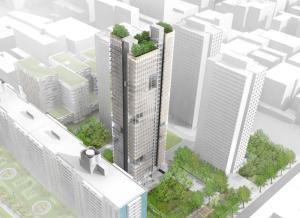 For the past three years, New York University has been massaging Greenwich Village.
For the past three years, New York University has been massaging Greenwich Village.
The school, with a beefed up community affairs operation, has thrown bones to preservation groups (consenting to the landmarking of a large NYU block); adjusted plans to demolish a building with a theater when faced with opposition; and held a recurring set of community forums with the goal of improving town-gown relations (the topic this month: “NYU’s Haitian Relief Efforts”).
The effort—aimed at shedding the historically strained, and at times abysmal, relationship with the pernickety Village—is all a prelude to the university’s planned major expansion over the next two decades, as it seeks to increase its holdings by 6 million square feet, a key initiative of NYU president John Sexton.
Early next month, NYU is set to publicly unveil the master plan for this expansion effort, termed “NYU 2031: NYU in NYC ” for the school’s bicentennial, plotting a route toward achieving its goals to boost the student body by 5,500, grow its housing space by 3 million square feet as it hosts more students and faculty in NYU-owned housing, and grow the academic space as well. The school has previously said it wants around 3 million square feet in or around its current Village campus.
The most contentious aspect of this plan will surely be the growth of the school in the Village itself, where there’s a set that seems ready to scream and yell the moment anyone proposes putting a shovel in the ground.
To this end, according to two people briefed on NYU’s general plans, the school intends to move ahead with an earlier circulated proposal to build a tall residential tower in its I.M. Pei-designed Silver Towers complex, among other plans. An earlier draft plan called for a 40-story tower to rise on the site, a modernist tower-in-the-park development that holds a Pablo Picasso sculpture in its central courtyard. (It was this site that NYU consented to have landmarked.)
Whatever the specifics of the plan, it is clear that the unveiling will merely be a beginning, and the most jarring elements will likely need extensive public approvals (the Silver Towers plan would seem to need approvals from the Landmarks Preservation Commission and the City Planning Commission, which can take years, and would need votes by the City Council as well).
TO SOFTEN THE INITIAL blow of the plans, NYU in 2007 began a listening tour of sorts, broadcasting its intentions and taking feedback. It held open houses for residents with large poster boards of conceptual plans; residents were encouraged to leave sticky notes indicating a preference or distaste for each board (negative, of course, outweighed the positive by a large margin).
To lead the planning effort, the school brought in a large team of respected architects, including Grimshaw, Toshiko Mori Architect and SMWM. Its community relations staffers, vice president Alicia Hurley and former Community Board 5 district manager Gary Parker, are respected by many in the community. It has brought on an array of other consultants, including the Marino Organization for public relations, and filings list Geto & deMilly as lobbyists for the school. And university officials have, since 2006, sat on a frequently-meeting task force convened by Borough President Scott Stringer, devoted entirely to talking about the expansion.
“We’ve been in a three-year planning process that deeply involved the community; we’ve listened a lot, and we’ve heard a lot,” said John Beckman, an NYU spokesman. “That’s why NYU’s strategy for the first time is looking to develop as much outside our core and neighborhood as inside it.”


